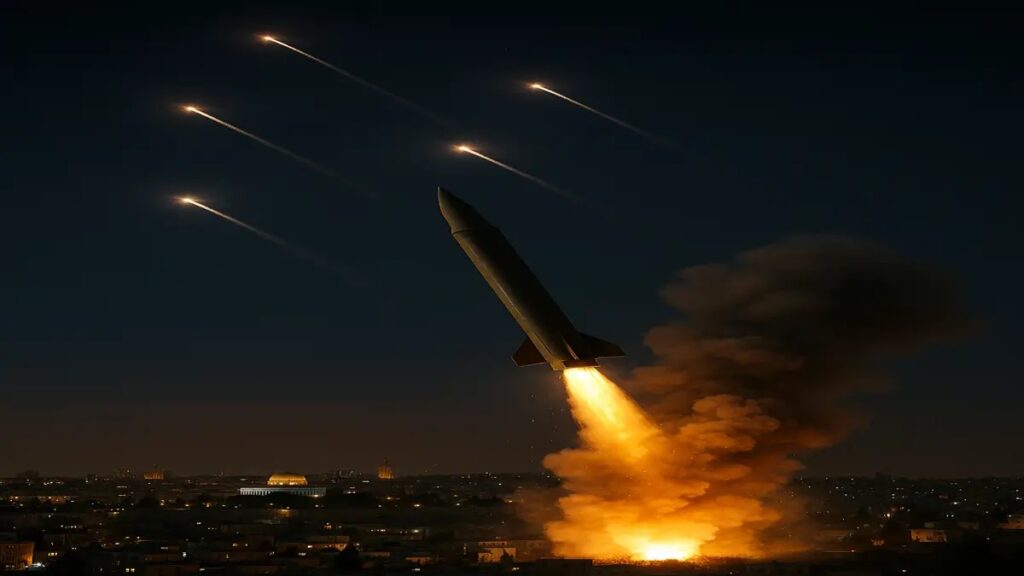Introduction: Iran Strikes Back on Israel
At approximately 19:00 BST on June 13, alarm systems blared across Israel as Iran unleashed a volley of ballistic missiles targeting multiple regions inside Israeli territory. Iran’s Revolutionary Guard confirmed the operation—dubbed “True Promise 3”—striking military sites and airbases in response to earlier Israeli attacks on Iranian nuclear facilities .
This escalation marks a new, dangerous chapter in the ongoing conflict. Explosions lit up the night sky, smoke spiraled over major cities like Tel Aviv and Jerusalem, and frightened residents were urged to take shelter. Below, we bring you a detailed, human-focused report on the rapidly unfolding situation.
A Night to Remember: Iran’s Retaliation and Israel’s Jitters
As dusk turned to night, residents across Israel were jolted by air‑raid sirens. Reports came in of explosions—some intercepted mid‑air, others resembling direct hits . In Jerusalem, visitors and citizens alike rushed into underground shelters.
An eyewitness described it as “windows rattling from loud booms,” with flashes of missile interceptions streaking across the sky . By 19:58 BST, rescue services were already on high alert. Magen David Adom confirmed at least five individuals had sustained shrapnel injuries near Tel Aviv, all in stable condition .
Meanwhile, Iranian state media reported that two Israeli fighter jets were shot down—details not verified independently . The Iranian government also confirmed that Tehran’s air defenses had activated in response to Israeli incursions earlier in the day .
The Origins of the Flare
This dramatic escalation stems from a series of recent Israeli strikes on Iran’s nuclear program—attacks targeting Isfahan and Natanz nuclear sites, which reportedly destroyed facilities involved in uranium enrichment .
Iran’s Supreme Leader, Ali Khamenei, warned that Israel “will not escape unscathed” for these strikes and pledged a firm response . Within hours, Iran launched scores of missiles aimed at strategic military positions in Israel.
Israel responded in kind, intercepting many missiles mid-flight, though at least some reached their targets. Tel Aviv skyline was illuminated by smoke plumes, triggering urgent alerts for city-wide sheltering .
Diplomacy at a Crossroads: The Global Stakes
The White House expressed concern over the intensity of Israel’s reprisals. While President Trump stated the U.S. had been alerted in advance, officials maintained that America was not directly involved . Speaking to U.S. media, Trump described Israel’s actions as “excellent” but suggested they reflected a strategy to bring Iran back to diplomatic negotiations .
American Secretary of State Marco Rubio clarified that Washington did not coordinate the Israeli strikes. Still, Trump’s comments reveal a delicate balancing act—endorsing Israel while hinting at diplomatic motives .
Analysts caution that this approach carries high risk: forcing Iran into a corner may drive Tehran to accelerate its nuclear ambitions in the name of self-defense .
What It Looks Like on the Ground
Israeli Defense Forces confirmed intercepting most of the missile barrage but warned of more potential strikes. They advised civilians to stay close to protected spaces and avoid gatherings until further notice .
Rescue workers, including those from Magen David Adom, sprang into action—deploying crews across Tel Aviv’s metropolitan area. Five people were taken to hospitals after sustaining injuries from shrapnel or debris .
Multiple media outlets shared grainy footage of missile streaks and air-defense interceptions over Jerusalem and Tel Aviv, painting a stark image of urban conflict. Reuters provided images of bright, fiery flashes illuminating the night sky over Jerusalem .
Breaking Point: High-Stakes Gamble
Experts describe both countries’ actions as a dangerous gamble. Israel’s preemptive strikes indicate a strategic objective: to halt Iran’s nuclear push before it reaches an irreversible stage .
From Tehran’s perspective, Iran demonstrated its capacity to retaliate, asserting military resolve and delivering a message of deterrence. Yet, this tit-for-tat exchange heightens fears of broader escalation.
Frank Gardner and Paul Adams, BBC correspondents, noted that the conflict is spiraling quickly with indications of further planned attacks .
What Happens Next?
- Military activity: Israel has pledged to sustain its operations until Iran’s nuclear capability is neutralized . Iran may respond with more missile launches or asymmetric tactics.
- Civilian precautions: Israeli authorities are urging continued vigilance. People are told to stay indoors and remain near shelters until the government signals it’s safe.
- Diplomatic ripple effects: As global powers watch closely, any miscalculation risks drawing regional and international players deeper into conflict. The U.S. could face growing pressure to act as mediator—or inadvertently escalate the situation.
Why This Matters
This confrontation underscores a critical turning point in Middle East stability. It isn’t just a military exchange—it’s a collision of military strategy, nuclear non-proliferation, civilian security, and geopolitical chess.
Iran’s ability to strike Israel, even if intercepted, signals it retains firepower—and the will—to retaliate. Israel’s determination to attack Iranian nuclear sites signals its zero-tolerance stance on perceived existential threats.
But every launched missile, every intercepted projectile, brings us closer to a tipping point where diplomacy may no longer suffice.
Bottom Line: The events of June 13, 2025, mark a dramatic escalation between Israel and Iran. With Israel targeting Iran’s nuclear infrastructure and Iran responding with ballistic missiles, the region enters a precarious phase. Civilians face disrupted lives and rising anxiety. The global community now has little time to act—either to de-escalate or risk a broader conflagration. Even if diplomacy ultimately prevails, the shadow of conflict now looms larger than before.

